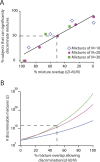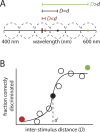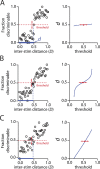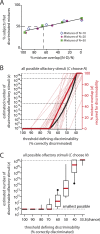The number of olfactory stimuli that humans can discriminate is still unknown
- PMID: 26151673
- PMCID: PMC4491703
- DOI: 10.7554/eLife.08127
The number of olfactory stimuli that humans can discriminate is still unknown
Abstract
It was recently proposed (Bushdid et al., 2014) that humans can discriminate between at least a trillion olfactory stimuli. Here we show that this claim is the result of a fragile estimation framework capable of producing nearly any result from the reported data, including values tens of orders of magnitude larger or smaller than the one originally reported in (Bushdid et al., 2014). Additionally, the formula used to derive this estimate is well-known to provide an upper bound, not a lower bound as reported. That is to say, the actual claim supported by the calculation is in fact that humans can discriminate at most one trillion olfactory stimuli. We conclude that there is no evidence for the original claim.
Keywords: human; neuroscience; olfaction; psychophysics; sensory systems.
Conflict of interest statement
The authors declare that no competing interests exist.
Figures











References
-
- Agrell E, Vardy A, Vardy E, Zeger K. Upper bounds for constant-weight codes. IEEE Transactions on Information Theory. 2000;46:2373–2395. doi: 10.1109/18.887851. - DOI
-
- Freiman CV. Upper bounds for fixed-weight codes of specified minimum distance. IEEE Transactions on Information Theory. 1964;10:246–248. doi: 10.1109/TIT.1964.1053677. - DOI
-
- Jiang T, Vardy A. Asymptotic improvement of the Gilbert-Varshamov bound on the size of binary codes. IEEE Transactions on Information Theory. 2004;50:1655–1664. doi: 10.1109/TIT.2004.831751. - DOI
MeSH terms
LinkOut - more resources
Full Text Sources

